LEARN MORE about spill response and absorbents
Spills happen. Containers leak. Even careful workers have accidents.
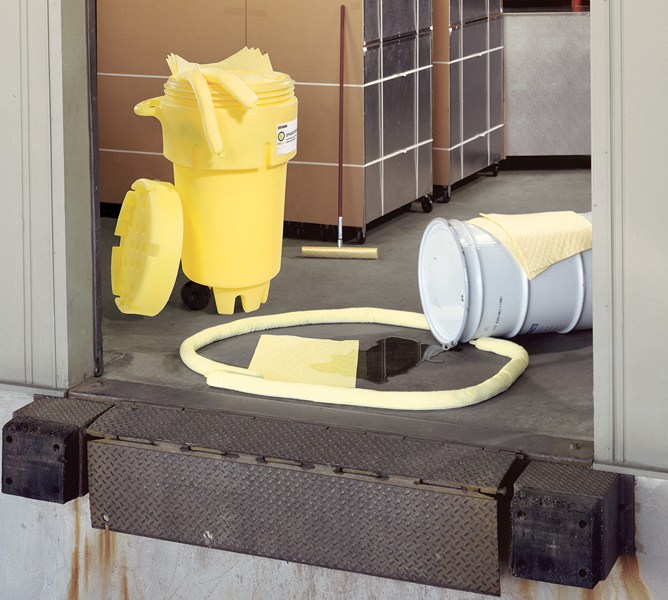 The consequences of spills can be serious:
The consequences of spills can be serious:
-
Wet spills damage materials and equipment.
-
Flammable spills cause fires.
-
Acid and caustic spills eat into surfaces or burn people.
-
Volatile or toxic spills pour hazardous pollutants into the air or surface waters.
-
Organic waste spills contaminate and stink.
-
With any liquid spill, people can slip and fall, injuring themselves.
From a practical standpoint, spill containment and cleanup just makes good sense. It protects personnel and property, eases tasks and workflow, saves time and money.
From a social standpoint, spill containment and cleanup reduces negative impact on your community, complaints about hazardous or unpleasant fumes, soil and water contamination, potential slip, slide, or fall risks on public traffic surfaces.
From a legal standpoint, spill containment and cleanup are required by government safety and environmental regulations, which can impose severe and costly penalties for noncompliance.
-
Regulations that govern spill response
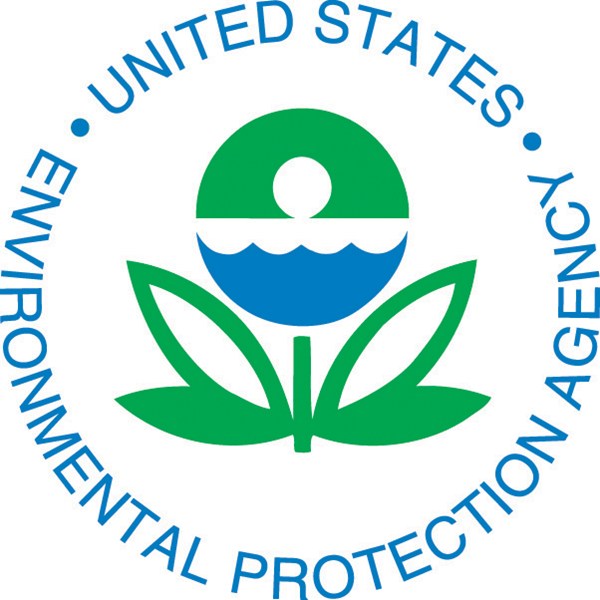
The Environmental Protection Agency, through the Resource and Conservation Recovery Act (RCRA) requires that a place of business with spillable hazardous chemicals have a Spill Prevention, Control, and Countermeasure plan (SPCC).
This means any place with potentially hazardous liquids in storage must store them so that, if the original container leaks, the environment will be protected. Secondary containment systems must be used, and supplies for quick cleanup must be present.
-
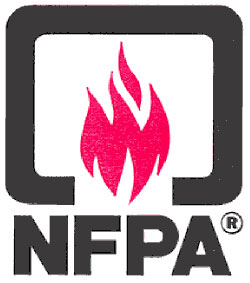 National Fire Protection Association issues the Uniform Fire Code (UFC) that requires that facilities storing hazardous materials that fall under the UFC provide containment for preventing hazards from leaks. NFPA 30, Flammable and Combustible Liquids Code, outlines the safest practices for storing, handling, and using flammable and combustible liquids and is regarded as law throughout the US and enforceable under OSHA.
National Fire Protection Association issues the Uniform Fire Code (UFC) that requires that facilities storing hazardous materials that fall under the UFC provide containment for preventing hazards from leaks. NFPA 30, Flammable and Combustible Liquids Code, outlines the safest practices for storing, handling, and using flammable and combustible liquids and is regarded as law throughout the US and enforceable under OSHA.
-
 The Occupational Safety and Health Administration requires that the floor of every workroom be maintained in a clean and, so far as possible, a dry condition. Where wet processes are used, drainage must be maintained and gratings, mats or raised platforms provided.
The Occupational Safety and Health Administration requires that the floor of every workroom be maintained in a clean and, so far as possible, a dry condition. Where wet processes are used, drainage must be maintained and gratings, mats or raised platforms provided.
-
Major spill types
-
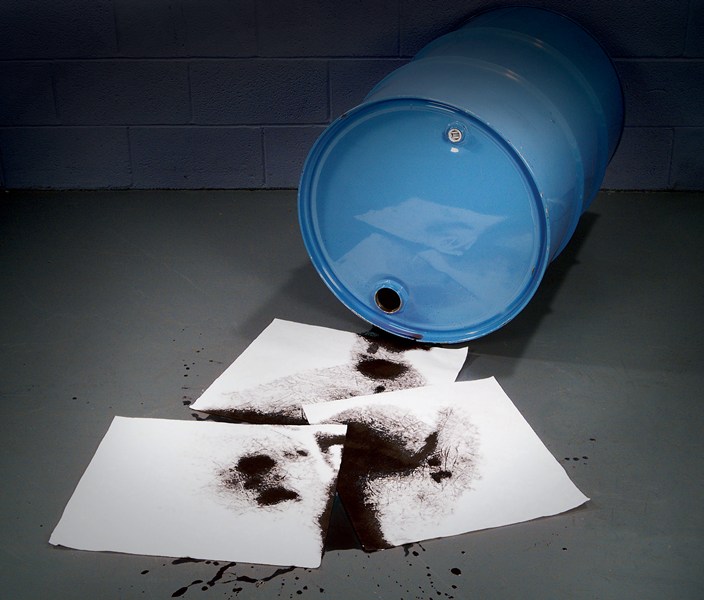 Flammable such as gasoline, solvents, oils
Flammable such as gasoline, solvents, oils
-
Acid such as pickling liquid, battery acid, acid drain cleaner
-
Caustic such as liquid lye, caustic drain cleaner
-
Oxidizing such as bleach
-
Water-based such as food products, machining coolants, rinse water
-
Contaminating such as sewage, vomit, urine, animal waste, blood
-
Petroleum-based (often the same as flammable spills) such as oils and greases
-
These categories can overlap. Cooking oil would be a flammable spill only, but lubricating oil might be both flammable and petroleum-based. Any spill can cause slip-and-fall risks.
-
Choice of a containment and cleanup method must consider all factors.
-
Where to look for drips, leaks and spills
There are probably no facilities without some type of drips, leaks, or spills. Anywhere liquids are manufactured, refined, transported, stored, or used, the possibility exists.
Lubricants – Most working equipment uses lubricants and will eventually leak. Some machines have drip pans, but even those can overflow or spill while being emptied.
Hydraulic fluids – Any equipment operated hydraulically can leak. Pumps, seals, valves, and hoses eventually wear out or break. Result: a messy, unsafe area around the equipment.
Cutting and/or cooling fluids – Used extensively in machine shops to reduce friction and heat and prevent metal welds from heat and pressure. Because they are constantly supplied to open, moving surfaces, these fluids eventually drip off.
Solvents and degreasers – Regular plant maintenance uses solvents and degreasers in large quantities to clean and degrease things. They are sometimes sprayed on hard-to-reach areas; and, wherever they are sprayed, they run off.
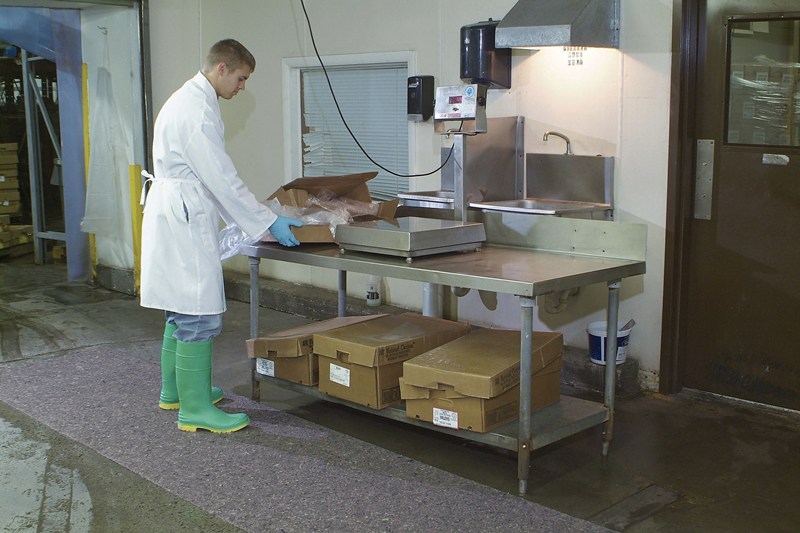 Food-grade oils – The food industry uses vegetable oils, fats, and greases in production processes; they also are a food-processing byproduct. Food-grade oils are used as lubricants for production-line food processing, cutting, and packaging equipment. Cooking oils and greases routinely get splashed on floors in kitchens.
Food-grade oils – The food industry uses vegetable oils, fats, and greases in production processes; they also are a food-processing byproduct. Food-grade oils are used as lubricants for production-line food processing, cutting, and packaging equipment. Cooking oils and greases routinely get splashed on floors in kitchens.
Paints and inks – In the printing industry and any manufacturing process where paints are applied, the potential exists on a routine, daily basis for overspray, overuse, leaks, drips, and spills.
Fuel oils – Anywhere fuel oils are processed, stored, transported, used, or dispensed, spills can happen. Refineries, storage terminals, tanker trucks, barges, etc., are candidates for this type of spill.
-
Typical sorbent applications
Automotive assembly and parts plants – Used around assembly lines, especially engine and transmission areas. Extensive hydraulic and robotic systems leak and make sorbents useful throughout the entire plant.
Textiles – Around looms and spinning frames, under cams and change gears. Useful in printing and resin finishing cleanup. Around oil-heated calenders and drum storage areas.
Wood and paper mills – Around oil-heated dryers and hydraulic slitters. Resin and polymer cleanup in particleboard and plywood mills. Useful for paint, varnish, and stain cleanup.
Plastic and rubber – Around injection molding machines and epoxy layups. For viscous liquid polymer cleanup, around calenders, presses, drums, and storage tanks. For parts wipedown and polishing.
Metal stamping and steel mills – Metal stamping uses extensive hydraulic systems, with resulting line leaks and drips. Cold-rolled steel coils from large steel mills are coated with oil that drips. Use sorbents in the roll storage area.
Printing – Useful for cleaning up minor spills around printing presses and storage bins.
Food industry – Use around vegetable oil, syrup, and syrup drums. All around cottonseed, soybean, shortening, and animal oil mills. Useful for responding to hydraulic line leaks in food processing areas. Useful for piping, packaging, and storage areas in breweries, wineries, and dairies.
-
Industry standards for sorbent products
Different products have been created for different types of applications, resulting in Application and Color-Coding Standards for sorbent products.
Application standards
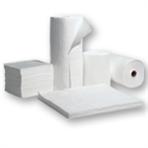 Absorbent Mats (pads and rolls) – Used for absorbing liquids on larger surface areas. Ideal for walkways and overspray areas, around machines and for contained spills. Pads and rolls are available in a variety of sizes and packaging configurations.
Absorbent Mats (pads and rolls) – Used for absorbing liquids on larger surface areas. Ideal for walkways and overspray areas, around machines and for contained spills. Pads and rolls are available in a variety of sizes and packaging configurations.
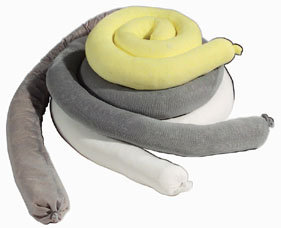 Absorbent Socks – Used for containing leaks. drips and spills. Used to minimize the cleanup area, Most often packaged in a box; size and quantity per package vary.
Absorbent Socks – Used for containing leaks. drips and spills. Used to minimize the cleanup area, Most often packaged in a box; size and quantity per package vary.
Absorbent Pillows – Used for absorbing large-volume leaks, drips and spills over a larger surface area. Most often packaged in a box or poly bag; size and quantity per package vary.
-
Color coding standards
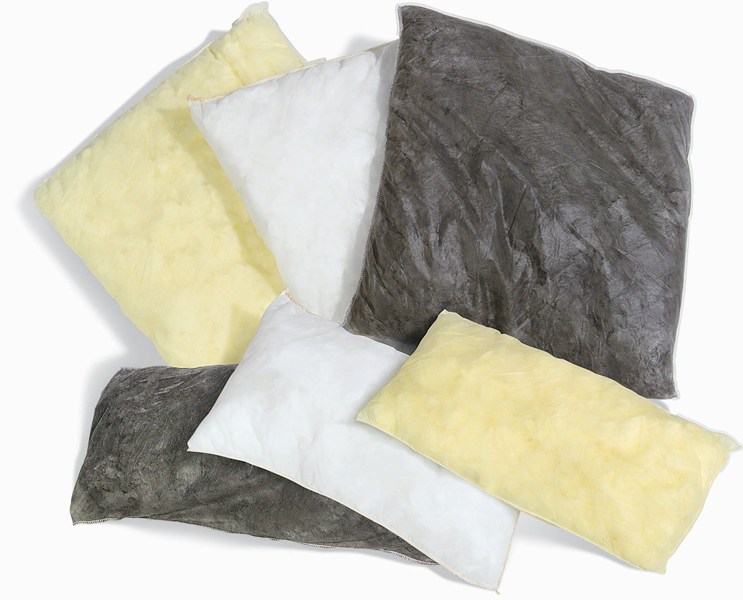 White – Hydrophobic, oil absorbents material that repels water while sorbing oil-based liquids. Typically used for spills or contamination on water, or for drips and leaks that are outdoors and subject to weather conditions.
White – Hydrophobic, oil absorbents material that repels water while sorbing oil-based liquids. Typically used for spills or contamination on water, or for drips and leaks that are outdoors and subject to weather conditions.
Gray – Hydrophilic, universal material that absorbs oils, coolants, solvents and water. Typically used for maintenance, repair and operations (MRO) applications inside facilities, or for leaks, drips and spills around machinery, loading areas, etc.
Yellow or Pink – Hydrophilic, universal material that sorbs oils, coolants, solvents, water and aggressive liquids. Typically used for HazMat absorbent applications where the spilled liquid poses a hazard to humans, or for applications where the nature of the spilled liquid is unknown.
-
How to use sorbents
Step 1: Clean all loose, spent absorbents, rags and other debris from the area.
Step 2: Place a fresh sorbent directly on top of the problem area. Watch as it pulls in liquids.
Step 3: When the pad or roll is fully saturated, simply pick it up and dispose of it. You'll know when it's fully saturated when you see liquids puddling around or passing underneath the sorbent. Don't forget to replace it with a fresh sorbent.
Helpful hints
-
Cover a spill evenly, making sure even stray droplets are covered.
-
For best results, use white absorbents for oil-only applications (will repel water) and gray or yellow for universal or hazardous applications.
-
Although the sorbents themselves are not hazardous, the liquid they absorb might be. A sorbent will take on the hazardous characteristics of anything it absorbs. Therefore, it is important that you dispose of the sorbent in a manner that is consistent with the liquid itself. Consult the chemical's Material Safety Data Sheet (MSDS) for further disposal information.
How to use socks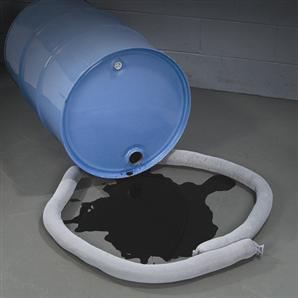
Step 1: Clean all loose, spent sorbents, rags and other debris from the area.
Step 2: Place an absorbent sock around the problem area. Watch as it pulls liquids into the center of the sock.
Step 3: When the sock is fully saturated, simply pick it up and dispose of it. You'll know when it's fully saturated when you see liquids puddling around or passing underneath the sock. Don't forget to replace it with a fresh sock.
-
Helpful hints
-
When placing socks, it helps to hold the sock at each end and shake the filler until it is even.
-
For best results, do not stack absorbent socks on top of loose sorbents or each other.
When using more than one sock to surround a problem area, make sure you overlap the edges by three inches. This will prevent leakage between the socks.
-
Where to go for more information
U.S. Environmental Protection Agency (EPA) www.epa.gov
U.S. Occupational Safety and Health Administration (OSHA) www.osha.gov
National Fire Protection Association www.nfpa.org
-
Spill control definitions
Abatement – Reducing the degree or intensity of, or eliminating, pollution
Absorb – To take a liquid in through pores in a surface or open spaces in a network and pull them to the center, like a sponge
Absorbent sock – Continuous fabric tube filled with absorbent material, used for containing spills in a limited area by quickly surrounding, blocking, and absorbing the spilled material. Available in various lengths, easy to handle, quick to deploy, durable, stable, bendable, and moldable
Absorbent pillow – Fabric bag filled with absorbent material, used for quick absorption of large volumes of liquid in a limited area
Absorbent pad – Sheet of absorbent material used to catch and control low-volume spills in work areas to help prevent slip and fall hazards and protect surfaces next to potentially staining or damaging liquid materials
Acid absorbent – Absorbent agent for use when acid spills need pickup that includes a chemically basic component so it is also capable of neutralizing the acid
Adsorb – To gather or store a substance on the surface in an extremely thin, condensed layer; takes advantage of mutual attraction of certain substances for each other; excellent for use on petroleum-based spills in water
Boom – Extra-long absorbent sock designed for encircling spills on water
Caustic Absorbent -- absorbent agent for use when caustic spills need pickup that includes a chemically acid component so it is also capable of neutralizing the caustic
Cradle-to-grave or manifest system – Procedure in which hazardous materials are identified and followed as they are produced, treated, transported, and disposed of by a series of permanent, linkable, descriptive documents (e.g. manifests)
Drain seal or drain cover – Catchment device used in floor drains to temporarily prevent hazardous spilled materials from entering drain systems and contaminating wastewater disposal facilities and surface runoff
EPA – Environmental Protection Agency
Hazardous waste – Products that pose a substantial or potential hazard to human health or the environment when improperly managed. Described by at least one of the following: ignitable, corrosive, reactive, or toxic; or appears on special EPA lists
HAZWOPER – Hazardous Waste Operations and Emergency Response Standard, OSHA regulation that governs employers and employees involved in hazardous waste cleanup operations
Hydrophilic – Attracted to water; good quality for a product used to clean up water-based spills
Hydrophobic – resists water and will not absorb water or any water-based solutions; good quality for a product used to clean up floating petroleum-based spills
NFPA – National Fire Protection Association
OSHA – Occupational Safety and Health Administration
Pathogens – Microscopic life forms that can cause disease.
pH – Number that tells how acid or alkaline a chemical solution is. It can range from 0 to 14. A pH of 7 is neutral, less than 7 acidic, greater than 7 alkaline. An example of a low-pH solution would be battery acid; an example of one with high pH would be lye. Small changes in pH mean big differences. A pH of 3 is ten times as acid as a pH of 4; a pH of 12 is ten times as alkaline as a pH of 11
Primary containment – Container in which a liquid is originally stored, such as a drum or a jug
Resource Conservation and Recovery Act (RCRA) – Federal law that manages and regulates the generation, transportation, and disposal of hazardous waste
Secondary Containment – Provision made to catch any liquid that leaks from the primary container. Example would be a basin under a drum storage rack or the pan under a machine tool
SPCC – Spill Prevention, Control, and Countermeasure, an Environmental Protection Agency program considered the most important part of EPA's effort to prevent oil spills from reaching surface waters. SPCC requires facilities to have a written plan to prevent oil spills, in addition to their contingency plans for handling oil spills that have already happened
UFC – Uniform Fire Code
Back